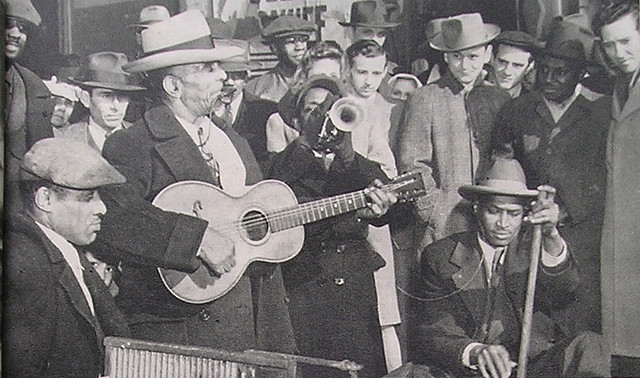Maxwell Street blues
By Rick Kogan

Maxwell Street blues
By Rick Kogan
There was a celebration Sunday to mark the 100th birthday of Maxwell Street. It was not a big party and not held on Maxwell Street—but rather at what is called the Maxwell Street Market at Des Plaines and Roosevelt.
I was there; and I was there too when Maxwell Street was dying. The fall of 1998, and I am there. The curbs are broken, the sidewalks smashed and thrown askew as if by a small earthquake. It was a shattered, tattered and shuttered street. The block east of Halsted is a mess of iron grates, plywood and broken glass windows, barely able to echo the vibrancy that was here for more than a century; a disorderly but delightfully dizzying mix of immigrant cultures and commerce and the blues.
The University of Illinois at Chicago, which owned much of the land in the area and is expanding its campus, moving in for the kill.
A group of concerned citizens, activists and blues performers formed the Maxwell Street Historic Preservation Coalition in an attempt to save something of the street. They have created a sculpture that spelled M-A-X in 10-foot-tall letters made of railroad ties, and the “Maxwell Street Wall of Fame,” a mural filled with names of former area residents, such as bluesman Bo Diddley, jazzman Benny Goodman and former Supreme Court Justice Arthur Goldberg.
Near the mural is a cardboard petition. Only five names and addresses are scrawled on it. It is obviously a losing battle.
Ira Berkow, a native Chicagoan and former New York Times sportswriter, wrote a history titled “Maxwell Street: Survival in a Bazaar.” He called Maxwell Street “the Ellis Island of the Midwest.”
Go there now and you will find on the corner a trio of gentrified neighbors: Jamba Juice, Caribou Coffee and a TV-filled sports bar called Morgan’s on Maxwell.
There is nothing wrong with change. A city is an organic thing. But when change eradicates important and vibrant parts of the past, a city becomes less alive.
There is a plaque on one building on Maxwell and some small informational stands, offering the most perfunctory history lessons, spaced along the chic, shop-filled block east of Halsted.
There are also three sculptures: A woman carrying a sack of groceries; a man presumably trying to sell tomatoes; a man playing the guitar. Produced by a company in Pennsylvania, these statues are not ugly. They are, in what they have to say about the price of progress, pathetic.
